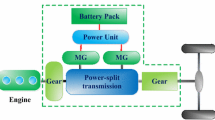Abstract
A hybrid electric vehicle (HEV) that uses multiple planetary gear units with clutches as transmission system is advanced for the powertrain performance, because the operation of the clutches can lead to distinct operating modes, and the induced possible operating modes provide additional freedom to deal with the energy optimal control problem. Under each operating mode, the powertrain mechanical system has specific dynamical behavior. In order to develop model-based optimization schemes that can tackle the transient operations of the vehicle, exact dynamical modeling is investigated focusing on a hybrid powertrain system that uses a two-planetary-gear transmission box with two clutches. It shows that according to the states of the two clutches, the powertrain system has the power-split mode, parallel mode and the electric vehicle (EV) mode. Finally, an analysis for the calculation of the desired driving torque and its application to the dynamic programming (DP)-based energy management indicate the significance of the developed exact dynamical models.
Similar content being viewed by others
Explore related subjects
Discover the latest articles and news from researchers in related subjects, suggested using machine learning.References
Ehsani M, Gao Y, Gay S, et al. Modern Electric, Hybrid Electric, and Fuel Cell Vehicles, Fundamentals, Theory, and Design. 2nd ed. CRC Press LLC, 2010
Zhang X W, Li S E, Peng H, et al. Efficient exhaustive search of power-split hybrid powertrains with multiple planetary gears and clutches. J Dyn Sys Meas Control, 2015, 137: 121006
Zhang X W, Peng H, Sun J. A near-optimal power management strategy for rapid component sizing of multimode power split hybrid vehicles. IEEE Trans Contr Syst Technol, 2015, 23: 609–618
Wang R, Lukic S M. Dynamic programming technique in hybrid electric vehicle optimization. In: Proceedings of IEEE International Electric Vehicle Conference, 2012. 1–8
Kim N, Cha S, Peng H. Optimal control of hybrid electric vehicles based on Pontryagin’s minimum principle. IEEE Trans Contr Syst Technol, 2011, 19: 1279–1287
Chen Z, Mi C, Xu J, et al. Energy management for a power-split plug-in hybrid electric vehicle based on dynamic programming and neural networks. IEEE Trans Veh Technol, 2014, 63: 1567–1580
Tang L, Rizzoni G, Lukas M. Comparison of dynamic programming-based energy management strategies including battery life optimization. In: Proceedings of International Conference on Electrical Systems for Aircraft, Railway, Ship Propulsion and Road Vehicles, 2016
Guo L L, Chen H, Gao B Z, et al. Energy management of HEVs based on velocity profile optimization. Sci China Inf Sci, 2019, 62: 089203
Borhan H, Vahidi A, Phillips A M, et al. MPC-based energy management of a power-split hybrid electric vehicle. IEEE Trans Contr Syst Technol, 2012, 20: 593–603
Zhang J, Shen T. Real-time fuel economy optimization with nonlinear MPC for PHEVs. IEEE Trans Contr Syst Technol, 2016, 24: 2167–2175
Guo L, Gao B, Li Y, et al. A fast algorithm for nonlinear model predictive control applied to HEV energy management systems. Sci China Inf Sci, 2017, 60: 092201
Moura S J, Fathy H K, Callaway D S, et al. A stochastic optimal control approach for power management in plug-in hybrid electric vehicles. IEEE Trans Contr Syst Technol, 2011, 19: 545–555
Di Cairano S, Bernardini D, Bemporad A, et al. Stochastic MPC with learning for driver-predictive vehicle control and its application to HEV energy management. IEEE Trans Contr Syst Technol, 2014, 22: 1018–1031
Zhang J, Wu Y. A stochastic logical model-based approximate solution for energy management problem of HEVs. Sci China Inf Sci, 2018, 61: 070207
Zhuang W, Zhang X, Li D, et al. Mode shift map design and integrated energy management control of a multi-mode hybrid electric vehicle. Appl Energy, 2017, 204: 476–488
Author information
Authors and Affiliations
Corresponding author
Rights and permissions
About this article
Cite this article
Zhang, J., Inuzuka, S., Kojima, T. et al. Dynamical model of HEV with two planetary gear units and its application to optimization of energy consumption. Sci. China Inf. Sci. 62, 222203 (2019). https://doi.org/10.1007/s11432-018-9864-8
Received:
Accepted:
Published:
DOI: https://doi.org/10.1007/s11432-018-9864-8




